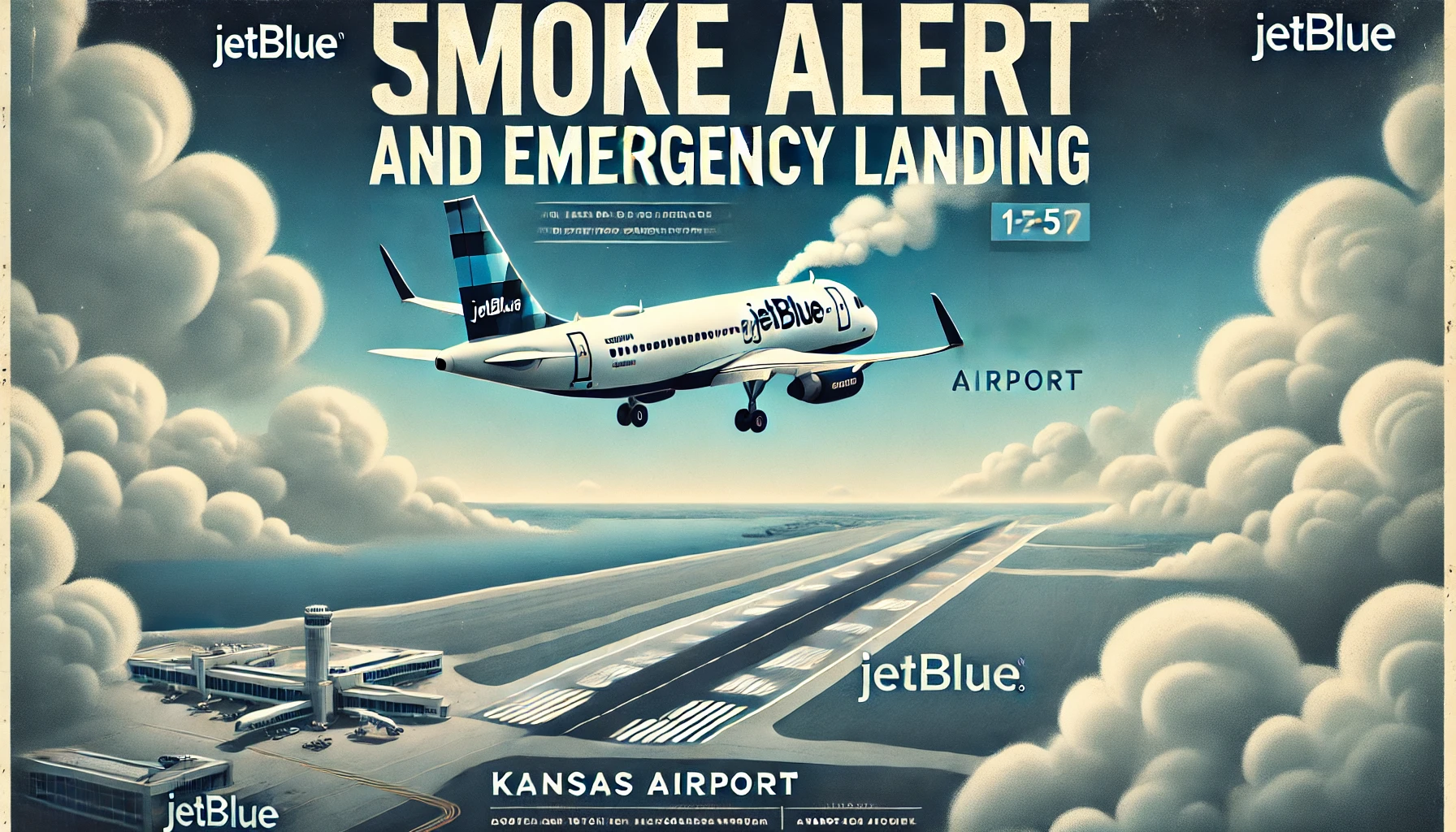How JetBlue Managed a Smoke Alert Emergency: A Closer Look at In-Flight Emergency Landings
In a matter of minutes, what began as a routine JetBlue flight turned into a heart-pounding experience for passengers as the aircraft made an emergency landing in Kansas. This JetBlue emergency landing wasn’t just another case of turbulence or a minor technical issue; it was a mid-air emergency that saw smoke filling the airplane cabin. Understanding the causes, protocols, and procedures that airlines like JetBlue follow in such situations can offer valuable insights into the intricacies of flight emergency protocols and the rapid descent that often comes with them.
What Happened: The JetBlue Smoke Incident
On a seemingly uneventful day, passengers on board a JetBlue flight found themselves in a terrifying situation. Smoke was detected in the airplane cabin, leading to an emergency landing at the nearest available airport—Kansas. According to reports, the smoke in the airplane cabin left some passengers in tears during the “intense few minutes” before the flight touched down. Despite the chaos, JetBlue’s crew followed strict flight emergency protocols, ensuring the safety of all passengers.
While the situation was undoubtedly stressful for everyone involved, it highlights the importance of emergency landing procedures and the swift response by flight crews trained for such incidents. Smoke in an airplane, while not common, is one of the more serious in-flight emergencies, and the crew must act quickly to avert potential disasters.
The Causes of Smoke in an Airplane Cabin
There are various reasons why smoke might fill an airplane cabin. These causes range from minor technical issues to more serious mechanical failures. In this particular JetBlue smoke incident, the specific cause wasn’t immediately clear, but here are some common reasons why airlines might experience such issues:
- Electrical malfunctions: Wiring issues or overheating equipment can lead to smoke without necessarily causing a fire.
- Hydraulic fluid leaks: Fluids can sometimes make contact with hot surfaces, leading to vapor or smoke.
- Overheated air conditioning units: If an airplane’s air conditioning system malfunctions, smoke can seep into the cabin.
- Engine issues: While rare, engine malfunctions can cause smoke to be released into the passenger area.
In the event of smoke detection, pilots typically respond with a rapid descent to bring the plane to a lower altitude for an emergency landing. Quick action is essential, as smoke can affect both visibility and breathing conditions for passengers and crew alike.
JetBlue’s Emergency Landing Procedure: A Closer Look
In-flight emergencies like this one are never taken lightly. Airlines like JetBlue train their crews extensively for every possible scenario. When smoke is detected, the crew immediately initiates the emergency landing procedure, which involves:
- Assessing the situation: The crew and pilots must quickly determine the source of the smoke and whether it’s a serious threat.
- Alerting air traffic control (ATC): The pilots notify ATC of the situation and declare an emergency. This allows them to get priority for landing and receive assistance on the ground.
- Choosing the nearest airport: The pilot calculates the safest and nearest landing spot. In this case, the JetBlue flight diverted to Kansas for the emergency landing.
- Executing a rapid descent: To minimize risks, pilots often initiate a rapid descent to reduce altitude quickly. This ensures a faster landing and lowers the chances of smoke exacerbating the situation.
- Emergency landing: The plane makes an emergency landing, and rescue teams are on standby to assist with the evacuation if necessary.
The Kansas emergency landing of the JetBlue flight is a textbook example of how well-trained crews can safely handle unexpected and potentially life-threatening situations.
What Passengers Should Know About Mid-Air Emergencies
For many passengers, the thought of a mid-air emergency is nerve-wracking. However, airlines have strict flight emergency protocols in place that are designed to manage situations like the JetBlue smoke incident. Here’s what every traveler should be aware of when flying:
- Pay attention to safety briefings: While these can feel repetitive, understanding where exits are and how to use oxygen masks can save lives.
- Stay calm: Emergencies are rare, but if one does occur, staying calm is essential for following crew instructions quickly and efficiently.
- Follow instructions: Whether it’s fastening your seatbelt, preparing for impact, or staying seated, listening to the flight attendants is critical during emergencies.
Even in scenarios like the JetBlue emergency landing, quick action by passengers and crew can make all the difference.
Why JetBlue’s Rapid Descent Was Necessary
In situations involving smoke, airlines often opt for a rapid descent. This technique allows the aircraft to quickly reach a lower altitude, which reduces the risk to passengers. During a mid-air emergency like the one JetBlue faced, the crew initiated a rapid descent to ensure that the plane could land as soon as possible. This kind of swift action is critical in situations involving smoke, as time can be a major factor in determining the outcome of the emergency.
Rapid descents are not only used for smoke incidents but also for other critical situations, such as loss of cabin pressure. The goal is always the same: to reduce risks and safely bring the aircraft to the ground.
Lessons Learned from the JetBlue Smoke Alert
Although the JetBlue smoke incident was undoubtedly frightening for those involved, it also serves as an important reminder of the need for strong emergency landing procedures. Airlines must be prepared for any situation, and passengers should feel reassured knowing that they are in capable hands.
- Crew training is critical: The crew’s swift actions during the JetBlue emergency landing highlight the importance of training and preparedness. JetBlue’s handling of the smoke alert demonstrates the value of well-rehearsed protocols in saving lives.
- Emergency procedures work: The emergency landing procedure is designed to bring planes safely to the ground, even in critical situations. JetBlue’s successful landing in Kansas is a testament to this.
- Understanding risks: While rare, emergencies such as smoke in an airplane cabin remind us that flight crews are trained for every possible scenario, making air travel one of the safest modes of transportation.
In the harrowing moments before the JetBlue emergency landing in Kansas, the flight crew demonstrated their expertise in managing mid-air emergencies. Through a combination of a rapid descent and well-executed emergency landing procedures, the situation was brought under control, and passengers arrived safely on the ground.
While the JetBlue smoke incident is a stark reminder of the potential risks involved in air travel, it also highlights how stringent flight emergency protocols keep passengers safe. For those interested in further learning about aviation safety and emergency preparedness, check out additional resources on flight safety at Regent Studies, a leading educational platform.
For more detailed information on how airlines handle smoke alerts and other emergencies, the FAA’s Emergency Response Manual is a valuable resource for understanding how regulations ensure the safety of all passengers in the air.



